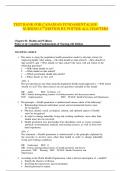TEST BANK FOR CANADIAN FUNDAMENTALSOF
NURSING 6TH EDITION BY POTTER ALL CHAPTERS
Chapter \01: \Health \and \Wellness
Potter \et \al: \Canadian \Fundamentals \of \Nursing, \6th \Edition
MULTIPLE \CHOICE
1. The \nurse \is \using \the \population \health \promotion \model \to \develop \actions \for
\improving \health. \After \asking, \―On \what \should \we \take \action?‖; \―How \should \we
\take \action?‖; \and \―Why \should \we \take \action?‖ \the \nurse \will \ask \which \of \the
\following \questions?
a. ―With \whom \should \we \act?‖
b. ―When \should \we \take \action?‖
c. ―Which \government \should \take \action?‖
d. ―Where \should \ we \ first \ act?‖
ANS: \ A
The \next \question \to \ask \when \using \the \population \health \model \approach \is \―With \whom
\should \we \act?‖ \The \other \choices \are \not \questions \included \in \this \model.
DIF: Apply REF: \13 \(Figure \1-5)
OBJ: \Contrast \distinguishing \features \of \health \promotion \and \disease \prevention.
TOP: \ Implementation MSC: \ NCLEX: \Health \Promotion \and \Maintenance
2. The \principle \―Health \promotion \is \multisectoral‖ \means \which \of \the \following?
a. Relationships \between \individual, \social, \and \environmental \factors \must
\be \recognized.
b. Physical, \mental, \social, \ecological, \cultural, \and \spiritual \aspects \of \health
\must \be \recognized.
c. In \order \to \change \unhealthy \living \and \working \conditions, \areas \other \than
\health \must \also \be \involved.
d. Health \promotion \uses \knowledge \from \disciplines \such \as \social, \economic,
\political, \environmental, \medical, \and \nursing \sciences, \as \well \as \from \first-
hand \experience.
ANS: \ C
The \statement \―Health \promotion \is \multisectoral‖ \is \the \principle \explained \by
\the \necessity \to \involve \areas \other \than \health \in \order \to \change \unhealthy
\living \and \working \conditions.
DIF: Understand REF: \11
OBJ: \ Contrast \distinguishing \features \of \health \promotion \and \disease
\prevention. \TOP: \ Planning MSC: \ NCLEX: \Health \Promotion \and
\Maintenance
3. According \to \the \World \Health \Organization, \what \is \the \best \description \of \―health‖?
a. Simply \the \absence \of \disease.
b. Involving \the \total \person \and \environment.
c. Strictly \personal \in \nature.
,d. Status \of \pathological \state.
,ANS: \ B
, WHO \defines \health \as \―. \. \.the \extent \to \which \an \individual \or \group \is \able, \on \the
\one \hand, \to \realize \aspirations \and \satisfy \needs; \and, \on \the \other \hand, \to \change
\or \cope \with \the \environment. \Health \is, \therefore, \seen \as \a \resource \for \everyday
\life, \not \the \objective \of \living; \it \is \a \positive \concept \emphasizing \social \and
\personal \resources, \as \well \as \physical \capacities.‖ \Nurses‘ \attitudes \toward \health
\and \illness \should \consider \the \total \person, \as \well \as \the \environment \in \which \the
\person \lives. \People \free \of \disease \are \not \equally \healthy. \Views \of \health \have
\broadened \to \include \mental, \social, \and \spiritual \well-being, \as \well \as \a \focus \on
\health \at \family \and \community \levels.
Conditions \of \life, \rather \than \pathological \states, \are \what \determine \health.
DIF: Knowledge REF: \2
OBJ: \Discuss \ways \that \definitions \of \health \have \been \conceptualized.
\TOP: \ Evaluate MSC: \ NCLEX: \Health \Promotion \and
\Maintenance
4. What \priority \strategy \for \health \promotion \in \Canada \is \optional \but \seen \as \important
\to \incorporate \in \nursing \education \curricula?
a. Knowledge \of \disease \prevention.
b. Strategies \for \health \promotion.
c. Policy \advocacy.
d. Concepts \of \determinants \of \health.
ANS: \ C
Increasingly, \policy \advocacy \is \incorporated \into \nursing \role \statements \and \nursing
\education \curricula. \Nurses \should \think \about \policies \that \have \contributed \to \health
\problems, \policies \that \would \help \alleviate \health \problems, \and \how \nurses \champion
\public \policies. \Disease \prevention, \health \promotion, \and \concepts \of \determinants \of
\health \are \integral \parts \of \nursing \curricula.
DIF: Understand REF: \11| \12
OBJ: \ Analyze \how \the \nature \and \scope \of \nursing \practice \are \influenced \by \different
conceptualizations \of \health \and \health TOP: \ Planning
\determinants. \MSC: \NCLEX: \Health \Promotion
\and \Maintenance
5. Which \of \the \following \is \a \prerequisite \for \health, \as \identified \by \the \Ottawa \Charter
\for \Health \Promotion?
a. Education.
b. Social \support.
c. Self-esteem.
d. Physical \environment.
ANS: \ A
Education \is \one \of \the \nine \prerequisites \for \health \that \were \identified \in \the \Ottawa
\Charter \for \Health \Promotion. \Lack \of \social \support \and \low \self-esteem \were
\identified \as \psychosocial \risk \factors \by \Labonte \(1993). \Dangerous \physical
\environments \were \identified \as \socioenvironmental \risk \factors \by \Labonte \(1993).
DIF: Understand REF: \4
OBJ: Discuss \contributions \of \the \following \Canadian \publications \to \conceptualizations
\of \health \and \health \determinants: \Lalonde \Report, \Ottawa \Charter, \Epp \Report,
\Strategies \for
Population \Health, \Jakarta \Declaration, \Bangkok \Charter, \Toronto TOP: Planning
\Charter. \MSC: \NCLEX: \Health \Promotion \and \Maintenance




